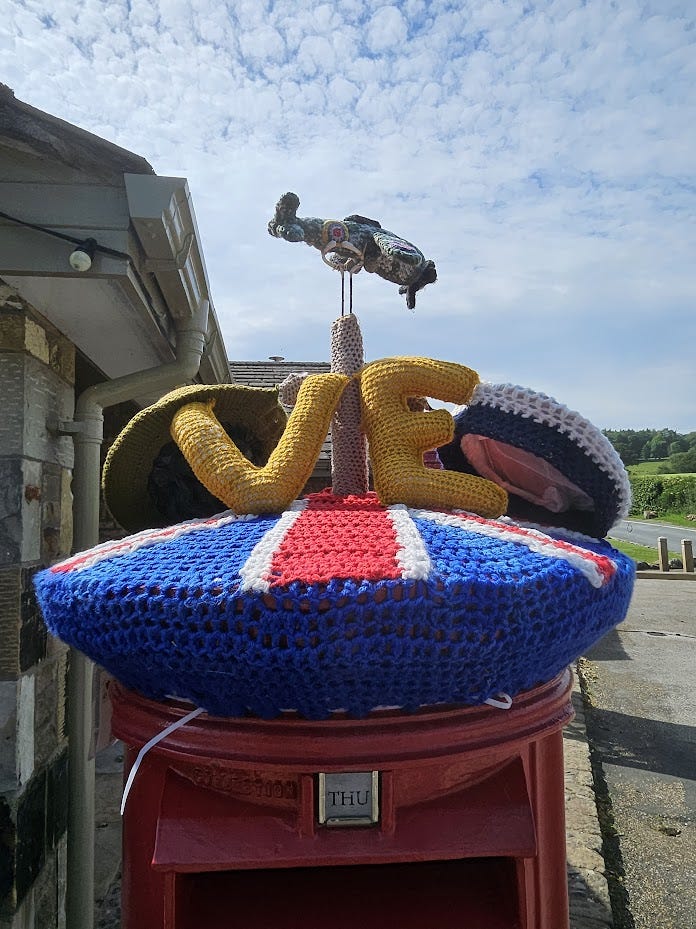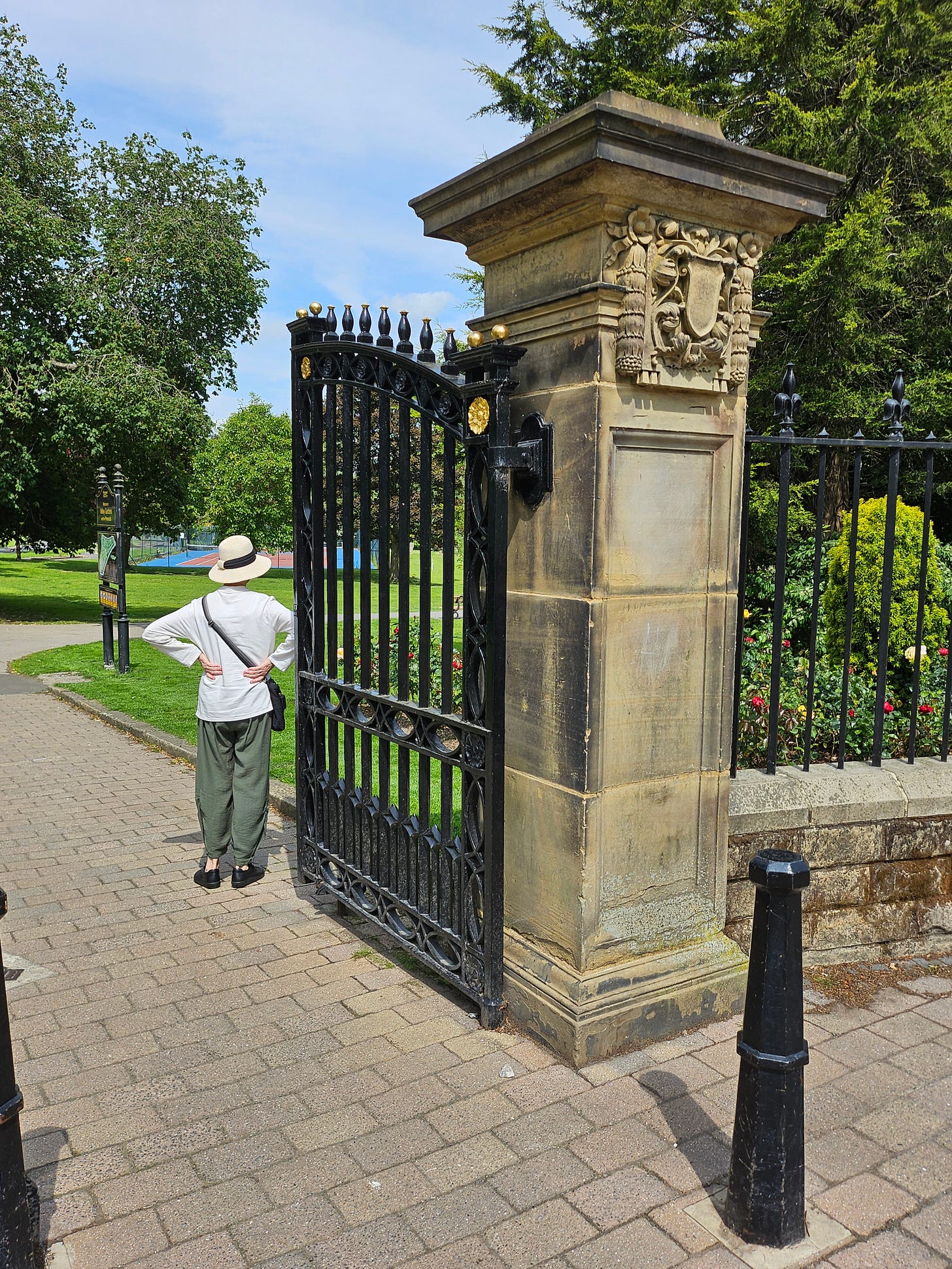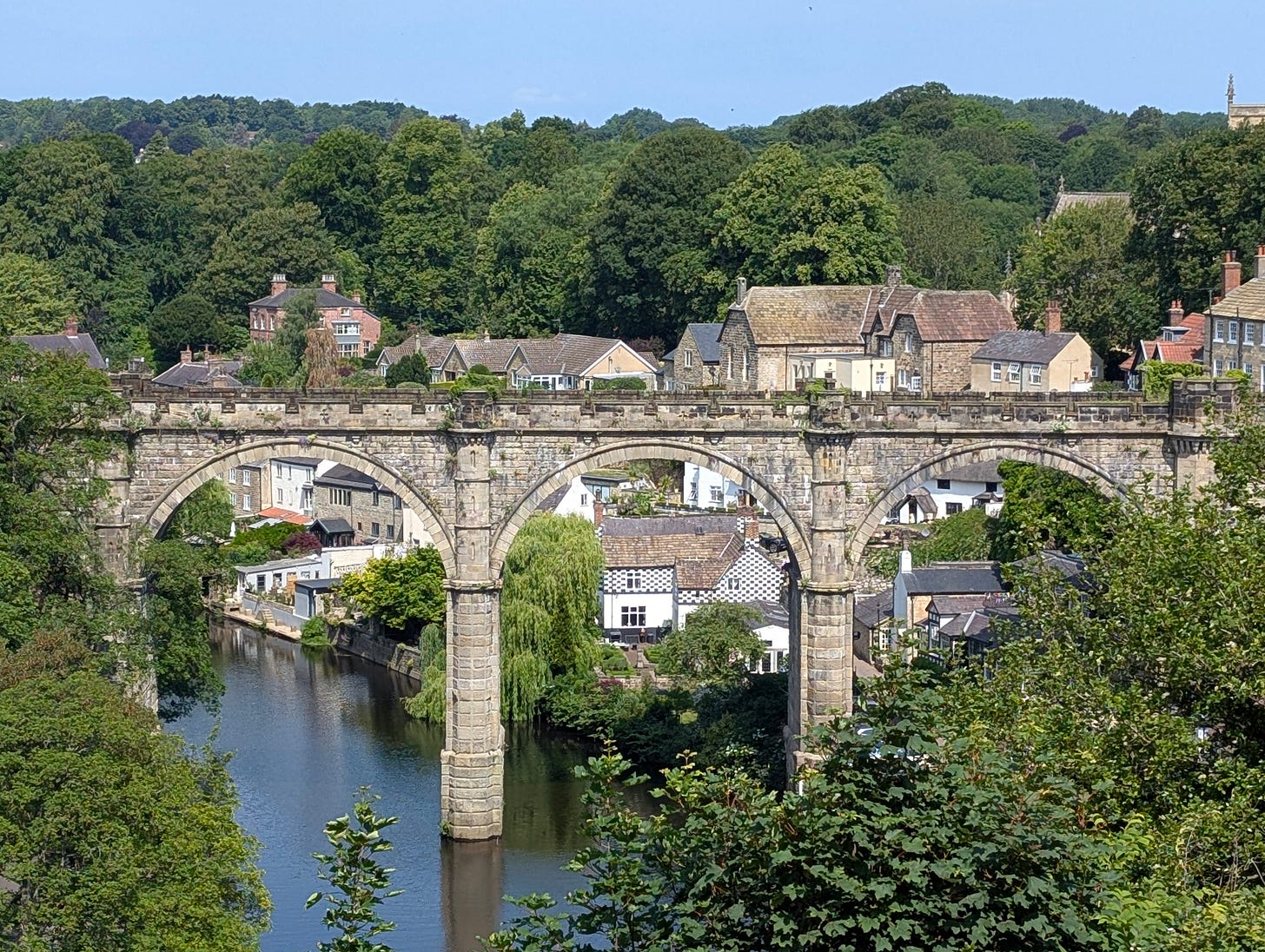We came across the greeting “You all right, then?” early on in our travels in Buxton, England. The first time a stranger came up to us and asked the question, it startled us because we thought we must look unwell. Turns out the greeting is more of an invitation to talk, as opposed to the “Good morning” plus curt head nod from someone passing by in the opposite direction.
I was sitting on a rear pew, in the cool of the nave of St. Peter’s church here in Harrogate, admiring the architecture and waiting for Penny to return from the post office, when a smiling man hobbled up the center aisle and greeted me with “You all right, then?” I knew what was coming: he leaned on his cane and started in talking about the church, how long he had been in the church, why he moved to Harrogate, his grandchildren, his work, his time in the army, his wife’s death, on and on. I had nowhere to go and nothing to do, so I was a willing audience, nodding my head to the rhythm of his monologue. People here are so friendly and talkative it can prove a problem if you’ve got things to do. But the tendency does profess a love of conversation, which is a virtue, a wonderful way to slow the clock down.
Gardens and Summer Dresses
Summer is in full bloom here and the small Victorian town is full of wonderful gardens. We live quite close to the public Valley Gardens, which is a joy. It is right next to Harlow Carr, a more formal garden created and maintained by the RHS (Royal Horticultural Society). The expansive and well-loved Valley Gardens are the heart of community life in Harrogate—with paths, pavilions, wells that once spouted sulphur, magnesia, and other chemicals, spacious meadows, meandering paths in the woods, and many diverse activities, including tennis courts, play equipment, and lawn bowling (We were invited to drop by for a lesson). It turns out lawn bowling is played with elliptical balls, that can, with the correct bowl, curve in an arc.
English women of all ages parade in summery print dresses and (sometimes) floppy sun hats that complement the blooms in the gardens. In July Penny and I will be going to a summer birthday party in Norwich and I’m lobbying for her to buy a flowery summer dress. She complains that if she wears it back home in Portland— where the look is more REI and Columbia Sportswear—she’ll stick out like a sore thumb. I say go for it. We’ll see who wins.
The Stray is another local park. It’s an expanse of about 200 acres of mostly grassy lawn to one side of Harrogate. The land was given by the Duke of Lancaster to Harrogate in The Great Award of 1778 as a place for farmers to graze cattle and sheep, to let them roam freely (“Stray”). Today, the land is guarded jealously by the city and the Stray Defence Association; if there is any encroachment on the land for highway expansion, a like amount of contiguous land must be carved out to compensate. Interested in commercial development on the Stray? Don’t even ask. The Stray is a favorite among Harrogate dogs (of which there are many), a place where they can retrieve sticks and balls or just romp in pure joy.
The Harrogate Baths

Harrogate was just another muddy crossroads when in 1571 word got out that the place was blessed with chalybeate (iron-rich) and sulfur springs, quite similar to the waters found in the Belgian town of Spa. One thing led to another and the town became a Regency Era watering hole. With the coming of the trains wealthy Londoners with various maladies flocked to Harrogate, turning it into a Victorian hot spot. The Old Swan Hotel, which I am looking at out my window, was essentially a private hospital with doctors who called on guests and prescribed various water-related fixes for those who wished privacy. You could ingest the an assortment of waters or sit in a bath of the stuff, cold or hot, swirling or still, on and on. There were public baths, too, where townspeople could sit and sip or plunge into the healing waters. The town grew as you might imagine, with Victorian amenities like an opera house, a theater, and posh hotels with names like The Queen’s Head or The Crown or The Majestic. A fashionable street (“Montpelier Gardens”) was devoted to shopping, where folks could see and be seen. A public hospital was built by private subscription in a corner of the Valley Gardens for the indigent poor, who had their own springs so as not to interfere with the swell folks. During World War I the town was turned into a hospital for injured servicemen. In World War II the town was the secret hiding place for the King, his family and the British government, in case of invasion. No newspapers or any other news came out of Harrogate or the surrounding area during the war years to ensure secrecy was complete. But by the time the soldiers left, Harrogate had passed its prime; nobody wanted to take the waters anymore. Today there is only one opportunity to bathe in the healing waters, at the elegant Turkish Bath. The Royal Bath House is now a Chinese restaurant. The Winter Gardens, where people sat and sipped water, is a bar. There is a public faucet at the elegant old Royal Pump Room (now a museum), but the town council put up a sign that warns you NOT to drink the water. The area around it smells of sulphur.
Bettys Tea House
Where is the possessive apostrophe in Bettys Tea House? It’s where Betty is, lost in obscurity. There probably never was a Betty, but that hasn’t stopped Bettys from becoming a Harrogate institution. Founded in 1919 by Frederick Belmont, a Swiss confectioner, Bettys is now the place to take tea or have a bite to eat. It is well-loved in town because (among many other good deeds promulgated by the family-owned company) Bettys not only has a good pension for years of service, but they continued to pay their staff during the Covid lockdown. We’ve eaten there a couple of times and will return again for afternoon tea (Yorkshire tea, of course).
The Harrogate Cenotaph
England lost a generation of young men in World War I and then another generation of young men in World War II. Monuments to the fallen are everywhere, and children still make wreaths of red plastic poppies to place on the memorials, adorned with ribbons that say “Lest we forget.” Harrogate has the Cenotaph in the center of town, an obelisk first dedicated in 1922 to the men of the Yorkshire county lost in the Great War, and then after World War II to the fallen from that conflagration. We went to a staged reading based on an oral history of an Englishman who participated in D-Day. Upon returning to his home after the war he vowed never again to pick up a gun, “not even at a carnival shooting gallery,” because he could not bear to remember the carnage he witnessed and the deaths he caused.

We came across another monument of a different sort while walking around Bolton Abbey, a few miles outside Harrogate. In 1882 Lord Frederick Cavendish (the Cavendishs owned the vast estate around the abbey) was tapped by the government at the time for the post of Chief Secretary to Ireland. In May 1882 he arrived in Ireland on the first day of his assignment … and within hours of setting foot in Dublin was blown up by the Irish National Invincibles. A fountain marks his passing.
Knaresborough
We like our bus adventures. The other day we bussed to Knaresborough for a great walk along the River Nidd. The town has what is advertised as “England’s oldest tourist attraction.” In 1630 hucksters started charging visitors to see Mother Shipton’s Cave and the amazing petrifying well. In the well, a fall of highly calcinated water “petrifies” objects over time. Mother Shipton the Seer proclaimed the end of the world if the Knaresborough viaduct fell down. Our Harrogate guide, a reliable fellow, tells us it’s all bunk. The rail viaduct is beautiful, though. I sure hope it doesn’t fall down.
English Royalty Is Here to Stay
Up in Scotland we talked with dedicated republicans who wanted nothing but independence from England. But ask them about the late Queen and you see them go all soft and dreamy. Same in Harrogate; they’ll say they don’t like royalty but just get them talking about the Queen and listen to the affection in their voices. King Charles? Maybe not so much, but Elizabeth? They can’t say enough good things about her: “She’s different.”
Last night we attended a concert at the beautiful Harrogate Royal Hall. The conductor strode to his podium and motioned for everyone to rise. The orchestra broke into a rousing God Save the King. Everyone around us sang out with gusto. It was the first time we’d heard “King” as the monarch in the song.
Wandering about Harrogate we came across a monument to Queen Victoria, erected on her 50th Jubilee on the throne, in 1887. I can only imagine the monuments that will go up over the next few years to Elizabeth II.
Penny put together an album containing a few photos of our time so far in Harrogate. You can access it by clicking here.










Nice work being a listening ear to someone who was probably lonely. The gift of time is a precious one. IMO, too many talkers in this world and insufficient listeners.
On your travels in the UK have you noticed how something as basic as the word for a humble bread roll changes from place to place? Stottie, bap, cob, scuffler, bread cake ( not a cake), muffin ( not a cake), etc,etc
The richness of language becomes plainer over time as communities become ever more connected geographically I guess.